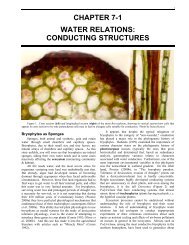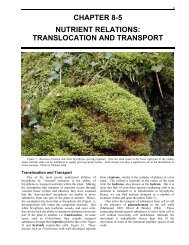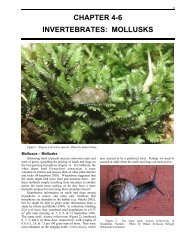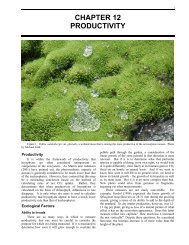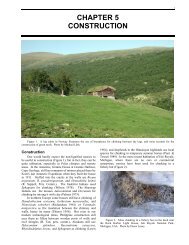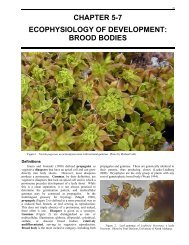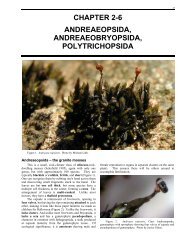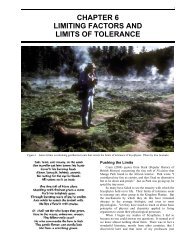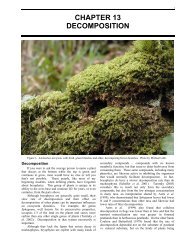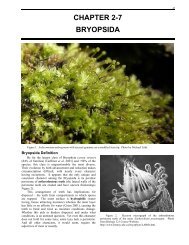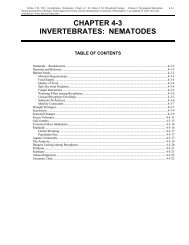Chapter 4-5: Adaptive Strategies - Bryophyte Ecology
Chapter 4-5: Adaptive Strategies - Bryophyte Ecology
Chapter 4-5: Adaptive Strategies - Bryophyte Ecology
Create successful ePaper yourself
Turn your PDF publications into a flip-book with our unique Google optimized e-Paper software.
38 <strong>Chapter</strong> 4-5: <strong>Adaptive</strong> <strong>Strategies</strong>: Growth and Life Forms<br />
Early classification of life forms had little relevance<br />
for bryophytes. Dansereau (1957, in Ricklefs 1990)<br />
classified plant life forms into trees, shrubs, herbs,<br />
epiphytes, lianas (vines), deciduous, evergreen, and<br />
bryoids. Raunkiaer (1934) relied primarily on winter<br />
characteristics and based his system on bud position:<br />
phanerophytes (phanero = visible) – tips of branches;<br />
moist, warm environments<br />
chamaephytes (chamae = dwarf) – shrubs and herbs, buds<br />
near soil; cool, dry climates<br />
hemicryptophytes (hemicrypto = half hidden) – die back<br />
to ground in winter; cold, moist<br />
cryptophytes (crypto = hidden) – buds buried by soil; cold,<br />
moist<br />
therophytes (thero = summer) – seeds; deserts, grassland<br />
Jargon of Life History<br />
First, perhaps it is necessary to distinguish between life<br />
history (or life cycle) traits and life forms. As During<br />
(1979) points out, holomorphy (total form, Hennig 1966;<br />
the German Gestalt) of plants resulting from their<br />
adaptations to their environments certainly relates to their<br />
strategies. However, the life strategy refers to life cycle<br />
characteristics and their timing (treated in the next chapter),<br />
whereas life form refers to the morphological characters of<br />
individuals as well. La Farge-England (1996) points out<br />
the inconsistencies in the literature regarding the term life<br />
form and supports Barkman (1979) by defining it as "the<br />
overall organization of growth form, branching pattern,<br />
general assemblage of individuals, and modification of a<br />
population by the environment." Growth form, she<br />
reminds us, is "the structural architecture of the individual<br />
moss plant." But such architectures can be modified by the<br />
environment, hence merging life form and growth form<br />
(Tangney 1998). It would seem simpler to define one as<br />
the genetically programmed form and one as the<br />
environmentally modified form, but the muddle in the<br />
literature has crossed those lines with both terms. Thus,<br />
even with the foregoing definitions, confusion in the use of<br />
terms will still be with us and I shall make little attempt to<br />
unravel their use in the literature presented here.<br />
Therefore, interpretation of their use should be done with<br />
caution.<br />
Growth Forms<br />
Since growth form is the simpler result of genetics, we<br />
should examine that first. As La Farge-England (1996)<br />
stated, the terminology of growth form, branching pattern,<br />
and position of perichaetia have been used inconsistently in<br />
the literature. This morass of literature makes it difficult to<br />
compare studies and to sort out the real meanings in<br />
nomenclature. After an extensive review of the literature<br />
and usage of the terminology, she recommended the<br />
following interpretations:<br />
1. Growth form is distinct from life form.<br />
2. Direction of growth does not necessarily imply<br />
perichaetial position; some acrocarpous mosses<br />
(having terminal perichaetia) grow horizontally,<br />
whereas some pleurocarpous ones (having<br />
perichaetia in lateral buds or on short side branches)<br />
grow erect.<br />
3. Cladocarpy (Figure 2) is distinct from pleurocarpy,<br />
with perichaetia terminal on lateral branches and with<br />
juvenile leaf development similar to that on vegetative<br />
branches; perichaetial branches have lateral primordia<br />
that potentially develop subperichaetial branches. (It<br />
is defined in Glossarium Polyglottum Bryologiae as a<br />
type of pleurocarpy having sporophytes borne<br />
terminally on short lateral branches, as in Fontinalis).<br />
4. Pleurocarpy is defined as having perichaetia terminal<br />
on lateral innovations that appear sessile and swollen<br />
along supporting axes. Juvenile leaves are<br />
morphologically different from those of vegetative<br />
branches. Perichaetial innovations lack lateral branch<br />
primordia and thus do not produce subperichaetial<br />
branches. Pleurocarpy is restricted to Hypnales,<br />
Hookeriales, and Leucodontales, including<br />
Spiridentaceae and Racopilaceae.<br />
Figure 2. Cladocarpous branches of Macromitrium<br />
microstomum. Photo by Janice Glime.<br />
But traditionally, growth forms of mosses have been<br />
divided into those that are acrocarpous (Figure 3) and<br />
stand vertically (orthotropic mosses) and those that are<br />
pleurocarpous and lie horizontally relative to the substrate<br />
(plagiotropic mosses; Figure 4) (Meusel 1935). This of<br />
course leaves a few out of the scheme, as noted by La<br />
Farge-England. The orthotropic mosses can be further<br />
divided into the protonema mosses (Figure 5), with short<br />
or non-existent shoots that wither after the sporophyte is<br />
produced, and turf mosses, with upright shoots that bear<br />
new shoots after the sporophyte forms and subsequently<br />
bear further archegonia and more sporophytes; these new<br />
growths are the innovations. The plagiotropic mosses<br />
(Figure 4) include thread mosses (e.g. Leskeaceae, some<br />
Amblystegiaceae), with little difference between the main<br />
stem and lateral branches, the comb mosses (e.g.<br />
Hypnaceae, Brachytheciaceae, Meteoriaceae), with a strong<br />
main shoot with many simple or branched lateral branches,<br />
and the creeping-shoot mosses (e.g. Leucodon, Antitrichia,<br />
Climaciaceae, Hypnodendraceae), with rhizomatous main<br />
shoots that give rise to upright main shoots.<br />
Figure 3. Acrocarpous growth form exhibited by<br />
Oncophorus wahlenbergii. Photo by Michael Lüth.




